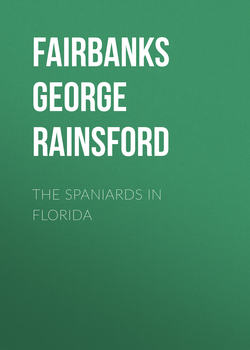Читать книгу The Spaniards in Florida - Fairbanks George Rainsford - Страница 4
CHAPTER II.
FIRST DISCOVERY, 1512 TO 1565 – JUAN PONCE DE LEON
ОглавлениеAmong the sturdy adventurers of the sixteenth century who sought both fame and fortune in the path of discovery, was Ponce de Leon, a companion of Columbus on his second voyage, a veteran and bold mariner, who, after a long and adventurous life, feeling the infirmities of age and the shadows of the decline of life hanging over him, willingly credited the tale that in this, the beautiful land of his imagination, there existed a fountain whose waters could restore youth to palsied age, and beauty to efface the marks of time.
The story ran that far to the north there existed a land abounding in gold and all manner of desirable things, but, above all, possessing a river and springs of so remarkable a virtue that their waters would confer immortal youth on whoever bathed in them; that upon a time a considerable expedition of the Indians of Cuba had departed northward in search of this beautiful country and these waters of immortality, who had never returned, and who, it was supposed, were in a renovated state, still enjoying the felicities of the happy land.
Furthermore, Peter Martyr affirms, in his second decade, addressed to the Pope, "that among the islands on the north side of Hispaniola, there is one about three hundred and twenty-five leagues distant, as they say which have searched the same, in the which is a continual spring of running water, of such marvelous virtue that the water thereof being drunk, perhaps with some diet, maketh old men young again. And here I must make protestation to your Holiness not to think this to be said lightly, or rashly; for they have so spread this rumor for a truth throughout all the court, that not only all the people, but also many of them whom wisdom or fortune have divided from the common sort, think it to be true."1 Thoroughly believing in the verity of this pleasant account, this gallant cavalier fitted out an expedition from Porto Rico, and in the progress of his search came upon the coast of Florida, on Easter Monday, 1512, supposing then, and for a long period afterwards, that it was an island. Partly in consequence of the bright spring verdure and flowery plains that met his eye, and the magnificence of the magnolia, the bay and the laurel and partly in honor of the day, Pascua Florida, or Palm Sunday, and reminded, probably, of its appropriateness by the profusion of the cabbage palms near the point of his landing, he gave to the country the name of Florida.
On the 3d of April, 1512, three hundred and fifty-five years ago, he landed a few miles north of St. Augustine, and took possession of the country for the Spanish crown. He found the natives fierce and implacable; and after exploring the country for some distance around, and trying the virtue of all the streams, and growing neither younger nor handsomer, he left the country without making a permanent settlement.
The subsequent explorations of Narvaez, in 1526, and of De Soto, in 1539, were made in another portion of our State, and do not bear immediately upon the subject of our investigation, although forming a most interesting portion of our general history.
1
The fountain of youth is a very ancient fable; and the reader will be reminded of the amusing story of the accomplishment of this miracle, told in Hawthorne's Twice-Told Tales, and of the marvelous effects produced by imbibing this celebrated spring water.
